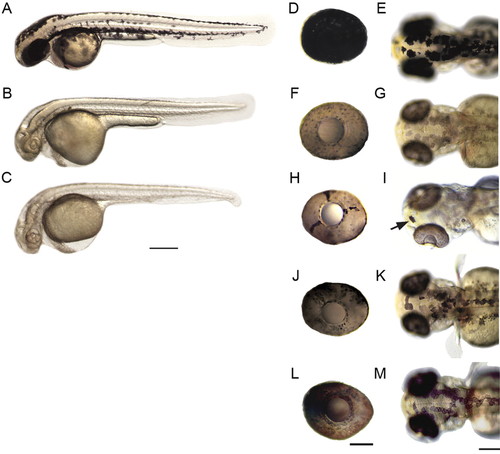Fig. 2
- ID
- ZDB-FIG-051223-4
- Publication
- Lamason et al., 2005 - SLC24A5, a putative cation exchanger, affects pigmentation in zebrafish and humans
- Other Figures
- All Figure Page
- Back to All Figure Page
|
Rescue and morpholino knockdown establish slc24a5 as the golden gene. Lateral views of 48-hpf (A) wild-type and (B) golb1 zebrafish larvae. (C) 48-hpf wild-type larva injected with morpholino targeted to the translational start site of slc24a5 phenocopies the golb1 mutation. Lateral view of eye (D) and dorsal view of head (E) of 72-hpf wild-type embryos. (F and G) golb1 pigmentation pattern at 72 hpf, showing lightly pigmented cells. (H and I) 72 hpf golb1 larva injected with PAC215f11 show mosaic rescue; arrow identifies a heavily pigmented melanophore. (J and K) 72-hpf golb1 larva injected with full-length zebrafish slc24a5 RNA. (L and M) 72-hpf golb1 larvae injected with full-length human European (Thr111) SLC24A5 RNA. Rescue with the ancestral human allele (Ala111) is shown in fig. S4. Rescue in RNA-injected embryos is more apparent in melanophores (K) and (M) than in RPE. Scale bars in [(A) to (C)], 300 µm; in (D), (F), (H), (J), and (L), 100 µm; in (E), (G), (I), (K), and (M), 200 µm. |

